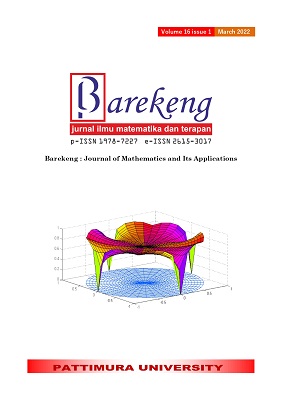STABILITY ANALYSIS OF TUNGRO DISEASE SPREAD MODEL IN RICE PLANT USING MATRIX METHOD
Abstract
Rice is one of the staple foods produced from the rice plant. Rice productivity is increased by carrying out efforts to control diseases that usually attack rice plants. Tungro is one of the most destructive diseases of rice plants. Mathematical models can help solve problems in the spread of plant diseases. In this paper, the development of a mathematical model for the spread of tungro disease in rice plants with 6 compartments is developed involving rice in the vegetative and generative phases. Furthermore, stability analysis is carried out on the obtained model by using the Basic Reproduction Number ( ) search through the matrix method, especially through the search for transition matrices and transmission matrices. The analytical results show that when 1 the non-endemic equilibrium point is stable and when >1 the endemic equilibrium point is stable. Numerical results showed that rice plants in the generative phase were more infected than rice plants in the vegetative phase.
Downloads
References
Moschini, P. M “Mathematical models for vector-borne diseases : effects of periodic environmental variations,” p. 98, 2014.
S. T. Ruiqing Shi, Haiyan Zhao, “Global dynamic analysis of a vector-borne plant disease model,” Adv. Differ. Equations, vol. 2014, no. 1, pp. 1–16, 2014, doi: 10.1186/1687-1847-2014-59.
Alemneh, H.T, et al, “Mathematical Modelling of MSV Pathogen Interaction with Pest Invasion on Maize Plant,” Glob. J. Pure Appl. Math., vol. 15, no. 1, pp. 55–79, 2019, [Online]. Available: http://www.ripublication.com/gjpam.htm.
Lazebnik. T, Bunimovich-Mendrazitsky. S, and Shaikhet. L, “Novel method to analytically obtain the asymptotic stable equilibria states of extended sir-type epidemiological models,” Symmetry (Basel)., vol. 13, no. 7, 2021, doi: 10.3390/sym13071120.
Ozair. M, Lashari. A, Jung. I. H, and Okosun. K. O, “Stability analysis and optimal control of a vector-borne disease with nonlinear incidence,” Discret. Dyn. Nat. Soc., vol. 2012, 2012, doi: 10.1155/2012/595487.
Khekare, “Stability Analysisof a Vector-borne Disease Model with Nonlinear and Bilinear Incidences,” Indian J. Sci. Technol., vol. 8, no. 12, pp. 83–89, 2015, doi: 10.17485/ijst/2015/v8i.
Rida. S.Z, Khalil. M, Hosham. H.A, and Gadellah. S, “Mathematical model of vector-borne plant disease with memory on the host and the vector,” Prog. Fract. Differ. Appl., vol. 2, no. 4, pp. 277–285, 2016, doi: 10.18576/pfda/020405.
Murwayi. A, Onyango. T, and Owour. B, “Mathematical Analysis of Plant Disease Dispersion Model that Incorporates wind Strength and Insect Vector at Equilibrium,” Br. J. Math. Comput. Sci., vol. 22, no. 5, pp. 1–17, 2017, doi: 10.9734/bjmcs/2017/33991.
Murwayi. A, Onyango. T, and Owour. B, “Estimated Numerical Results and Simulation of the Plant Disease Model Incorporating Wind Strength and Insect Vector at Equilibrium,” J. Adv. Math. Comput. Sci., vol. 25, no. 2, pp. 1–17, 2017, doi: 10.9734/jamcs/2017/36817.
Anggriani. N, “The effect of insecticide on the vector of rice Tungro disease: Insight from a mathematical model,” Inf., vol. 20, no. 9, pp. 6197–6206, 2017.
Anggriani. N, Ndii. M. Z, Arumi. D, Istifadah. N, and Supriatna. A. K, “Mathematical model for plant disease dynamics with curative and preventive treatments,” AIP Conf. Proc., vol. 2043, 2018, doi: 10.1063/1.5080035.
Anggriani. N, Mardiyah. M, Istifadah. N, and Supriatna. A. K, “Optimal control issues in plant disease with host demographic factor and botanical fungicides,” IOP Conf. Ser. Mater. Sci. Eng., vol. 332, no. 1, 2018, doi: 10.1088/1757-899X/332/1/012036.
Suryaningrat. W, Anggriani. N, Supriatna. A. K, and Istifadah N, “The optimal control of rice tungro disease with insecticide and biological agent,” AIP Conf. Proc., vol. 2264, no. September, 2020, doi: 10.1063/5.0023569.
Amelia. R, Anggriani. N, Istifadah. N, and Supriatna. A. K “Dynamic analysis of mathematical model of the spread of yellow virus in red chili plants through insect vectors with logistical functions,” AIP Conf. Proc., vol. 2264, 2020, doi: 10.1063/5.0023572.
Van den Bosch et al., “The basic reproduction number of vector-borne plant virus epidemics,” Virus Res., vol. 241, pp. 196–202, 2017, doi: 10.1016/j.virusres.2017.06.014.
De La Sen. M, Nistal. R, Alonso-Quesada. S, and Ibeas. A, “Some Formal Results on Positivity, Stability, and Endemic Steady-State Attainability Based on Linear Algebraic Tools for a Class of Epidemic Models with Eventual Incommensurate Delays,” Discret. Dyn. Nat. Soc., vol. 2019, 2019, doi: 10.1155/2019/8959681.
Authors who publish with this Journal agree to the following terms:
- Author retain copyright and grant the journal right of first publication with the work simultaneously licensed under a creative commons attribution license that allow others to share the work within an acknowledgement of the work’s authorship and initial publication of this journal.
- Authors are able to enter into separate, additional contractual arrangement for the non-exclusive distribution of the journal’s published version of the work (e.g. acknowledgement of its initial publication in this journal).
- Authors are permitted and encouraged to post their work online (e.g. in institutional repositories or on their websites) prior to and during the submission process, as it can lead to productive exchanges, as well as earlier and greater citation of published works.






1.gif)



